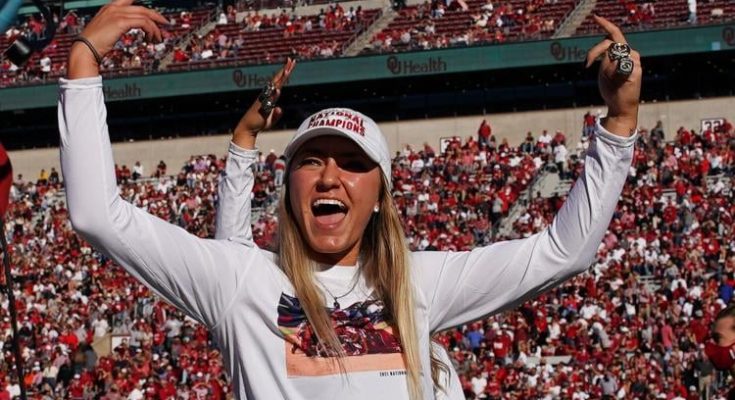**BREAKING: After Setting a New College Softball Attendance Record, Patty Gasso Reconsiders Hosting a Sooners Softball Game at Love’s Field**
In a stunning turn of events, Oklahoma Sooners head coach Patty Gasso is reportedly reconsidering her stance on hosting future games at Love’s Field after the program shattered the college softball single-game attendance record. The historic matchup against Oklahoma State, which drew an unprecedented 8,930 fans, showcased the explosive growth of the sport and the overwhelming support for the Sooners. However, despite the electric atmosphere and record-breaking turnout, Gasso has hinted at potential logistical and competitive concerns that may lead her to rethink the venue’s suitability for high-stakes games.
The atmosphere at Love’s Field was nothing short of electric as fans packed the stands, setting a new benchmark for college softball attendance. The previous record, held by the University of Florida at Katie Seashole Pressly Stadium (3,210 fans), was obliterated as Oklahoma’s passionate fanbase turned out in full force. The game itself was a thrilling display of elite softball, with the Sooners emerging victorious in a hard-fought battle against their in-state rivals. The energy was palpable, with chants, cheers, and a sea of crimson and cream creating an unforgettable experience for players and spectators alike.
For many, the record-setting night was a testament to the meteoric rise of Oklahoma softball under Gasso’s leadership. The Sooners have become the gold standard in the sport, boasting multiple national championships and a relentless winning culture. The decision to host the game at Love’s Field—a venue known for its intimate yet expansive setup—was seen as a bold move to elevate the program’s visibility and reward the loyal fanbase. Yet, despite the overwhelming success, Gasso’s post-game comments revealed a more cautious perspective.
While the record-breaking attendance was a cause for celebration, Gasso expressed reservations about whether Love’s Field can sustainably accommodate the growing demand for Oklahoma softball. In her post-game press conference, she acknowledged the incredible support but raised concerns about player safety, fan accessibility, and the overall game-day experience when dealing with such massive crowds.
“The support tonight was unreal—something I’ll never forget,” Gasso said. “But as a coach, my priority is making sure our players have the best possible environment to compete at their highest level. When you have nearly 9,000 people in a space not originally designed for that volume, there are challenges. Traffic flow, concessions, restroom access—it all becomes a factor. And for our players, the noise level was incredible, but at times, it was almost overwhelming.”
Her comments sparked immediate speculation about whether future marquee matchups might be moved back to the Sooners’ traditional home at Marita Hynes Field or even to a larger, more controlled environment. While Love’s Field offered a unique and vibrant setting, the logistical hurdles of managing such a large crowd could outweigh the benefits.
Several Sooners players echoed Gasso’s sentiments, describing the game as both exhilarating and exhausting. Senior captain Jayda Coleman admitted that while the energy fueled the team, the sheer volume of noise made communication on the field difficult at times.
“Don’t get me wrong—playing in front of that many people was insane in the best way,” Coleman said. “But there were moments where we couldn’t hear each other, and in a tight game like this, every little detail matters. It’s something we’d have to adjust to if we keep playing in venues like this.”
Pitcher Jordy Bahl, who delivered a clutch performance in the circle, added that while the crowd’s energy was motivating, the extended delays between innings—due to concession lines and fan movement—disrupted the team’s rhythm.
The record-breaking game has ignited a debate among Oklahoma fans. Many argue that Love’s Field should remain an occasional host for major games, citing the unparalleled atmosphere and the opportunity to grow the sport. Others, however, agree with Gasso’s concerns, pointing out that the logistical strain could detract from the on-field product.
Social media has been flooded with mixed reactions. Some fans praised the historic moment, calling it a “game-changer for softball,” while others questioned whether the venue could handle future events of this magnitude without significant upgrades.
Athletic director Joe Castiglione has yet to comment publicly on the matter, but sources within the athletic department suggest that discussions are already underway regarding potential adjustments. Options could include capping attendance at Love’s Field for future games, investing in infrastructure upgrades, or relocating marquee matchups to larger facilities such as USA Softball Hall of Fame Stadium in Oklahoma City—a venue with a proven track record of hosting massive softball events.
Regardless of the outcome, this game has undeniably left its mark on college softball. The fact that nearly 9,000 fans turned out for a regular-season matchup speaks volumes about the sport’s growing popularity, particularly in Oklahoma, where softball has reached near-legendary status thanks to Gasso’s dynasty.
For now, the question remains: Was this a one-time experiment, or the beginning of a new era for Sooners softball? Gasso’s hesitation suggests that while the record was a monumental achievement, the long-term viability of hosting such events at Love’s Field may require further evaluation.
One thing is certain—Oklahoma softball continues to push boundaries, both on and off the field. Whether the Sooners return to Love’s Field for another record-breaking night or opt for a more controlled environment, the legacy of this game will endure as a defining moment in the sport’s history.
As the debate continues, fans, players, and administrators alike will be watching closely to see what comes next for the most dominant program in college softball.



